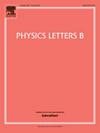Retuning radio astronomy for axion dark matter with neutron stars
IF 4.3
2区 物理与天体物理
Q1 ASTRONOMY & ASTROPHYSICS
引用次数: 0
Abstract
A model is constructed to predict the emission originating from axion-to-photon conversion in the strongly magnetized ultrarelativistic plasma of neutron stars. The acceleration and multiplicity of the charges are observed to shift the axion-induced spectral feature with respect to previous expectations. The frequency range of interest widens accordingly, and heavier dark matter axions may resonate in magnetospheric splits giving rise to detectable radio signals that could extend into the millimeter band. Ultimately, this work follows an affirmative answer to the question of whether neutron stars can give rise to any detectable high-frequency spectral feature that would allow us to probe axion dark matter of masses up to about a millielectronvolt. SGR 1745–2900 emerges as a particularly promising astrophysical laboratory for probing high-frequency axion dark matter.
求助全文
约1分钟内获得全文
求助全文
来源期刊

Physics Letters B
物理-物理:综合
CiteScore
9.10
自引率
6.80%
发文量
647
审稿时长
3 months
期刊介绍:
Physics Letters B ensures the rapid publication of important new results in particle physics, nuclear physics and cosmology. Specialized editors are responsible for contributions in experimental nuclear physics, theoretical nuclear physics, experimental high-energy physics, theoretical high-energy physics, and astrophysics.
 求助内容:
求助内容: 应助结果提醒方式:
应助结果提醒方式:


